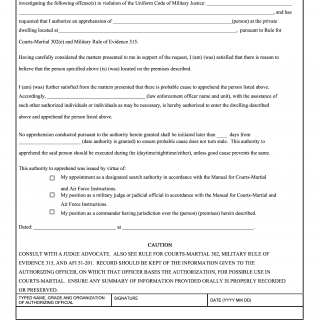AF Form 3226. Authority to Apprehend in Private Dwelling
AF Form 3226, also known as "Authority to Apprehend in Private Dwelling," is a legal document used in the United States Air Force for authorizing law enforcement officers to enter a private dwelling to apprehend a specific individual suspected of violating the Uniform Code of Military Justice (UCMJ). This form is essential to ensure that apprehensions are conducted lawfully and in accordance with established rules and procedures.
Key Sections and Fields:
-
Offense Investigation: This section identifies the law enforcement officer's name and unit, along with details of the offense(s) being investigated under the UCMJ.
-
Authorization: This section outlines the authorization granted by the commanding officer or designated search authority to apprehend the specific individual at the private dwelling. It specifies that the apprehension is being carried out in accordance with Rule for Courts-Martial 302(e) and Military Rule of Evidence 315.
-
Reason for Apprehension: It states the reason for apprehending the individual, typically based on the suspicion of a UCMJ violation.
-
Private Dwelling Location: This section provides the address of the private dwelling where the apprehension is authorized to take place.
-
Probable Cause: The form confirms that there is probable cause to apprehend the individual listed.
-
Authorized Personnel: It authorizes the specified law enforcement officer (and others as necessary) to enter the described private dwelling and apprehend the person.
-
Time Limit: There is a provision to specify the number of days within which the apprehension should be initiated to prevent probable cause from turning stale. This is followed by the date the authority is granted.
-
Daytime/Nighttime: Indicates whether the apprehension should be executed during the daytime, nighttime, or either, depending on circumstances.
-
Authority Source: This section clarifies the source of authority for issuing the apprehension order, which could be through appointment as a designated search authority, as a military judge or judicial official, or as a commander with jurisdiction over the person or premises.
-
Date and Location: The form includes spaces for the date when the authority is granted and the location where it is issued.
-
Caution and References: Advises the authorizing official to consult with a judge advocate and references the applicable rules and regulations, including Rule for Courts-Martial 302, Military Rule of Evidence 315, and AFI 51-201.
-
Signature and Details of Authorizing Official: The authorizing official's typed name, grade, and organization are included, along with the date when the authority is granted.
Note: The form emphasizes the importance of consulting with a judge advocate and maintaining a record of the information provided orally, as it may be used in courts-martial.
Caution: Previous editions of the form are considered obsolete.
AF Form 3226 is a critical document in the military justice system, ensuring that apprehensions in private dwellings are conducted in accordance with legal requirements and safeguards. It helps maintain the integrity of investigations and upholds the rights of individuals under military law.

